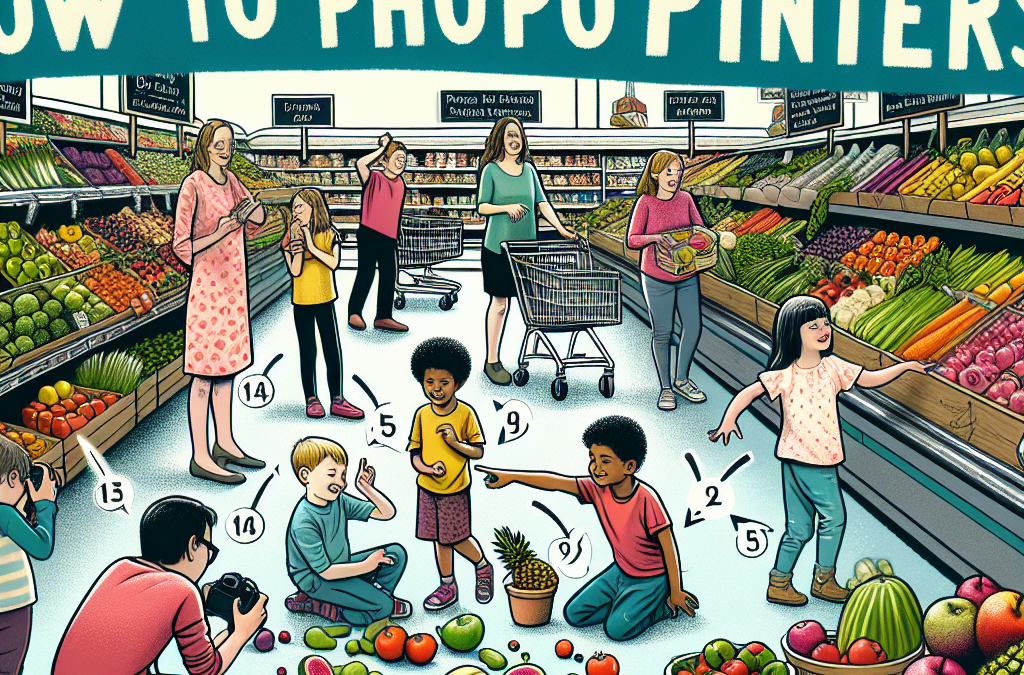1. Get Them Involved in the Kitchen
Let Them Choose Their Ingredients
One way I’ve found to make whole foods more appealing to kids is by letting them pick what goes into their dishes. It’s pretty amazing how much more excited they get about eating something just because they had a hand in choosing it. I often take my little ones to the grocery store with me and we make a game out of picking healthy options together.
Creating a mini-shopping list together makes them feel like they have a say in the cooking process. I encourage them to choose at least one fruit and one vegetable. When we get home, their enthusiasm almost guarantees they’ll want to help prep it, leading to some delightful culinary moments.
Letting kids choose isn’t just about ingredients; it can also be about the cooking techniques we use. For example, if they are interested in grilling, I take the opportunity to show them how to make grilled veggie kebabs. Trust me, they’re way more likely to eat them when they’ve been involved from the start!
Encourage Creative Cooking
One aspect of cooking with kids that I love is the opportunity for creativity. Kids are full of imaginative ideas, so I try to cultivate that in the kitchen. I give them the freedom to experiment by creating their unique snack. Sometimes, I’ll set out whole foods like yogurt, fruits, nuts, and seeds, and they can assemble their snack however they want.
This not only makes it fun but also helps them learn about food combinations without feeling forced. Watching them mix and match flavors is also a joy for me, and it often ends up being a tasty treat for all of us. Plus, who doesn’t love a little artistic flair on their plate?
Another creative aspect involves meal presentation. Letting them arrange food in fun shapes or patterns can be a game-changer. Even something as simple as making a smiley face with their meal makes them more interested in digging in!
Start Simple with Small Tasks
If your kids are new to the kitchen, I recommend starting small. Assign them simple tasks like washing veggies or stirring a pot. My kids love feeling like they’re the chefs of the family, and it’s crucial to take baby steps. This way, they won’t feel overwhelmed and more likely to participate.
As they build confidence, you can gradually give them more complex tasks, like chopping softer fruits or even blending smoothies. It’s all about progression and allowing them to feel accomplished in their skills. Plus, it creates a sense of teamwork which makes cooking together an enjoyable family activity.
Letting them be part of the cooking process leads to better eating habits over time. They become aware of the effort it takes to prepare meals, and I’ve found they appreciate food more when they’ve been part of making it!
2. Make Food Fun and Interactive
Build Your Own Meal Stations
Creating meal stations is one of my go-to techniques for making whole foods exciting. For instance, I’ll set up a taco night with various ingredients; kids get to assemble their tacos the way they like. This not only makes it fun but also encourages them to try new things without pressure.
By letting them construct their meals, kids are often more adventurous. They might surprise you by wanting to pile on the colorful veggies or trying out different salsas. I’ve noticed that the more choices they have, the more inclined they feel to explore holistic eating.
Another popular setup is a pizza bar where we use whole grain dough and different toppings. It’s totally customizable, and my kids love competing to create the wildest pizza possible—leading to some seriously delicious results!
Engage with Themed Meals
Themed meals bring an exhilarating twist to our dining experience. For instance, on days when we have time, I like to have an Italian night complete with homemade spaghetti and garlic bread. Sometimes we might throw in some Italian music for heightened fun!
Kids love these experiences, especially when they can dress up according to the theme. It turns meal time into a mini-party! I’ve found that these themes inspire them not only to eat but to engage in the cooking process more.
These themed nights create memories that help highlight the importance of family meals, where we can come together and share laughs. You’d be surprised what a little creativity in the kitchen can do for everyone’s mood!
Incorporate Food Art
Let’s be honest, kids are visual creatures. Making food art is a fantastic and creative way to spark their interest in healthy foods. For example, I love creating fruit kebabs and letting my kids turn them into animals or characters.
Food art garners excitement and amazement, and it makes them more eager to eat the healthy meals they’ve created. Sometimes the kids will turn their plates into little portraits, and I can’t help but smile! It’s all about turning the mundane into the imaginative.
I often share these creations with family and friends, and seeing my kids proud of their work justifies the effort. It leads to discussions about healthy eating as they start to recognize the colorful aspects of their meals. Plus, they’ll likely want to eat what they’ve made!
3. Educate and Explore Together
Teach Them About Nutrition
You know what I’ve realized? Kids are curious little beings! So I take full advantage of that by talking to them about nutrition and how it affects their bodies. Simple explanations about vitamins, minerals, and the benefits of different vegetables make it relatable.
When we go grocery shopping, I often point out items and discuss their health benefits. For example, explaining how spinach is great for strong muscles or how carrots help with eyesight helps create a connection between food and health. It’s super important to make these discussions engaging!
By weaving nutrition into our daily conversations, I’ve noticed they make better choices even when I’m not around. They love to tell their friends about the nutritional power of foods, and that gives them a sense of pride in their knowledge!
Explore New Flavors Together
As a family, we try to explore different cuisines from various cultures. We’ve discovered that being open to new flavors opens up a whole world of taste experiences! We’ll pick a country and prepare meals from there, which allows the kids to taste things they usually wouldn’t.
This approach encourages them to appreciate global cuisines while gathering fun facts about each culture. Sometimes we even have a themed night where we dress up, listen to music, and cook together. It turns into a cultural mini-adventure!
Trying new flavors has become a family tradition, and as they learn more, their curiosity has led them to ask for certain dishes when dining out too. I think breaking the mundane of regular meals with something new leads to exciting dinner conversations!
Grow Your Own Food
There’s nothing quite like planting seeds and watching them grow into food, right? I always find joy in gardening, and involving my kids** in that brings a whole new appreciation for what’s on their plates. Plus, it’s an educational experience to see how food is cultivated.
Get an Amazing Discount on the Best Certified Organic Whole Food Supplement!
We’ve started a small herb garden, which thrills them as they get to pick and use fresh herbs in our meals. They love watering the plants and checking their growth. I often joke that we might just become the next MasterChef, and they are all in on it!
When it’s harvest time, they get excited about cooking with fresh ingredients. Discussing the benefits of growing our food just deepens their understanding and makes it much more rewarding to eat what we’ve produced ourselves.
4. Create Healthy Snacking Options
Stock Up on Whole Food Snacks
One thing I’ve learned is that it’s easier to make healthy choices when you have whole food snacks readily available. I’m constantly stocking our pantry and fridge with nuts, seeds, dried fruits, and whole-grain crackers. It’s all about making healthy eating convenient!
I like to experiment with nut butter on rice cakes or fruits. When kids can grab this stuff easily, they won’t be as tempted by unhealthy junk you find around. I find it quite effective! Plus, having a variety of options keeps the snack time interesting.
It’s also vital to get them involved in the selection of healthy snacks. I often ask for their input while grocery shopping, which helps them feel invested in their choices. It works wonders for encouraging them to snack on healthy options!
Make Your Own Healthy Treats
Making our own treats at home has become a fun family activity! We create healthy versions of cookies and energy bars. Using wholesome ingredients allows us to indulge without guilt, and the kids love the process!
I’ve played around with various recipes that incorporate oats, nuts, and natural sweeteners like honey or maple syrup. When the kids get involved in baking, the excitement skyrockets, and they are way more likely to enjoy what they’ve made!
They feel connected to the food they eat, and we often share these healthy treats with friends and neighbors, making it a community event. There’s nothing like bonding over delicious homemade goodies!
Encourage Mindful Snacking
Teaching kids to be mindful about snacking has been quite remarkable! I started emphasizing the importance of paying attention to what they’re munching on rather than mindlessly snacking. It leads to better choices.
We often chat about why we choose whole foods over processed snacks and how they affect our bodies. By turning snack time into an educational moment, it fosters awareness and self-control regarding their choices.
For example, before diving into a snack, I encourage them to think about how they feel when they eat certain foods. This approach has led to empowered decisions on healthier options, which is a big win in our home!
5. Celebrate Food and Family Mealtimes
Organize Family Meals
Nothing beats sitting down together for a family meal! I make it a point to set aside time where everyone can gather at the table to share stories while enjoying our wholesome food. We often talk about our day, and it’s a fantastic way to bond.
Including whole foods as part of this ritual makes for a more enriching experience. I like to create a welcoming atmosphere by lighting candles and playing some soft music, turning meal times into a cherished tradition.
I’ve noticed that when the family comes together to eat, it enhances our focus on the food and the gratitude we have for it. It encourages healthy eating habits without making it feel like a chore!
Involve Age-Appropriate Tasks
Kids love to feel included, and involving them at mealtime makes a big difference. I ask for help with setting the table or preparing drinks. Little tasks help them feel responsible and a part of our collective effort to enjoy food together.
As the kids grow, so do the tasks! Eventually, they can contribute to meal prep, or even handle making salads. By empowering them in this way, I create a positive association with food that lasts.
Not only does it teach them skills for the future, but it also enhances the family bond as they realize their importance in the kitchen. It’s a win-win for everyone involved!
Show Gratitude for Our Meals
I always think of meal times as an opportunity to express gratitude for the food we eat. My family tends to share something they are thankful for before each meal. This practice cultivates appreciation for the food and the work that go into preparing it.
This moment of gratitude also sparks discussions about the origins of our food, from farm to table. It embeds a sense of respect for our meals while focusing on the importance of eating whole foods.
These discussions help kids understand the value of food and create a deeper connection to what they eat, making the whole experience much more enriching for everyone involved.
FAQs
1. How can I get my kids to eat more vegetables?
Getting kids to eat more veggies often involves making the experience fun. Involve them in picking and preparing vegetables together, and create colorful plates that appeal to their eyes. Sometimes, incorporating their favorite dips can make the veggies more enticing.
2. What are some easy whole food snacks I can prepare?
Some easy whole food snacks include sliced fruits with nut butter, whole grain crackers with cheese, or homemade trail mix with nuts and dried fruits. Simple, quick, and nutritious options will keep your kids satisfied.
3. How often should we have family meals?
Try to have family meals at least a few times a week. It builds a routine and offers a space for bonding. Even if it’s just for breakfast on busy days, it creates lasting memories.
4. Are themed meals suitable for everyday dinners?
Absolutely! Themed meals can happen any night of the week and don’t need to be fancy. Whether it’s pizza night or taco night, they add variety and excitement to your regular routine.
5. What’s the best way to introduce new foods to kids?
The best way is to keep it low pressure. Present new foods alongside familiar favorites and encourage kids to take just one bite. Making the experience casual and fun increases the chances they’ll want to try it again!




